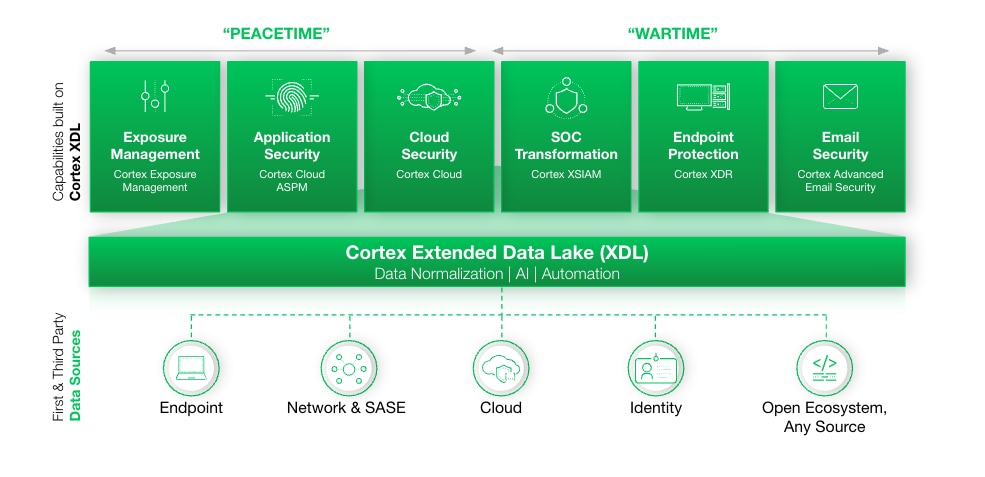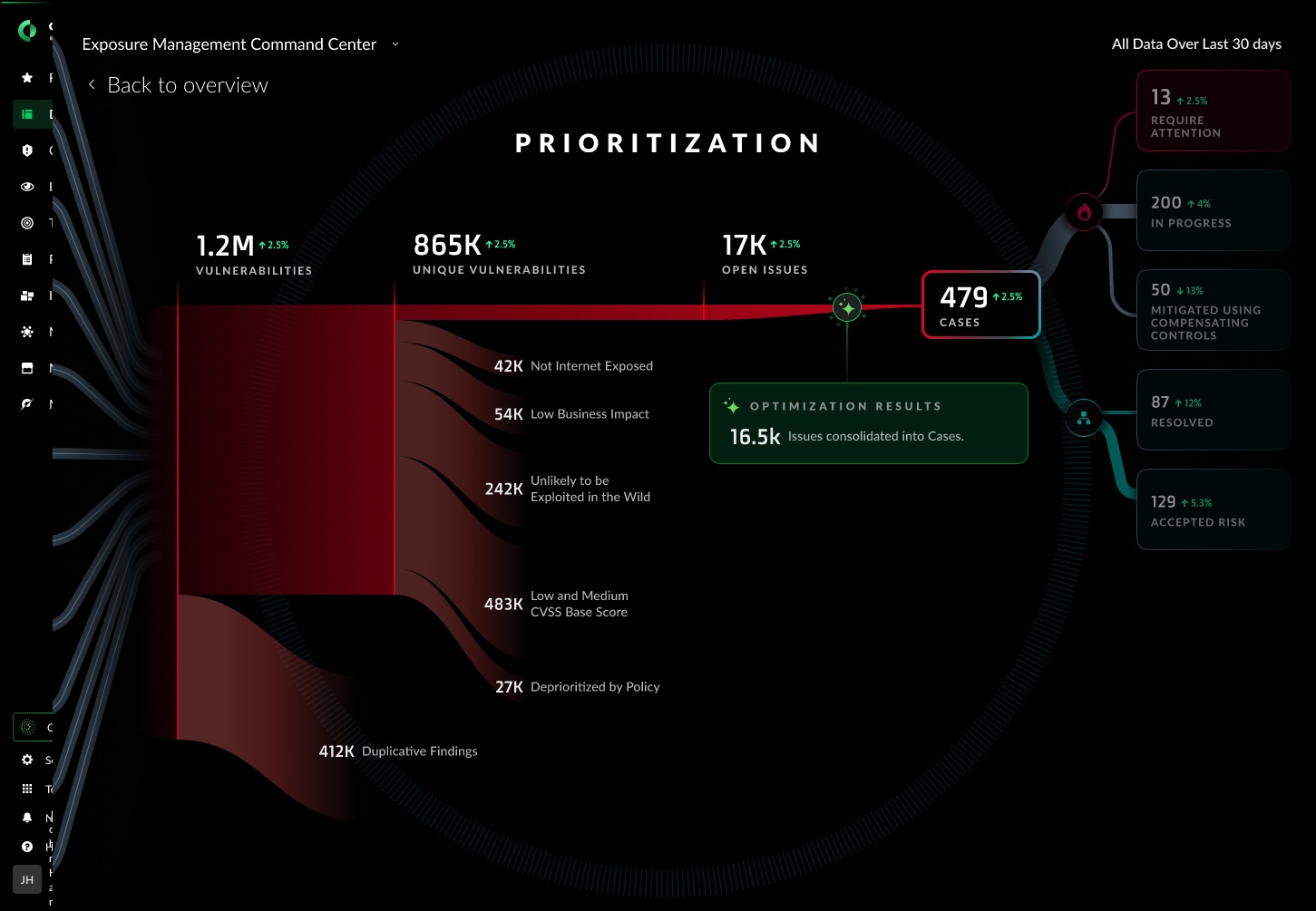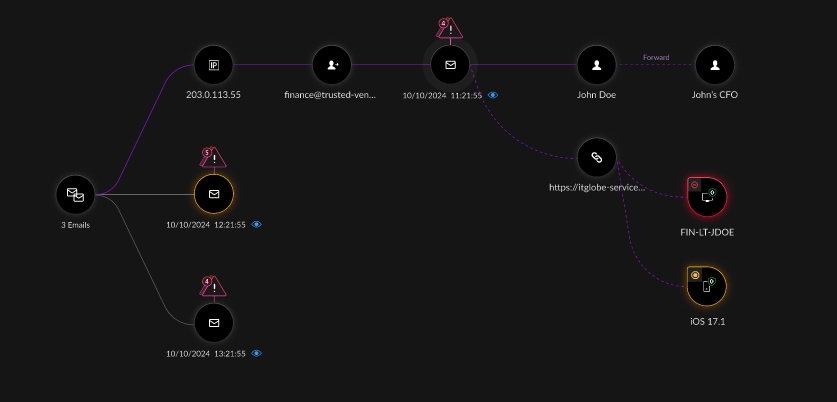Your security backlog grows because traditional defenses are fragmented. While modern cyberattacks cross network, email, and cloud boundaries in a single campaign, security tools remain in isolated silos. This critical data gap forces analysts to manually connect dots while attackers slip through, leaving your vulnerability management blind to active exploitation and your email security unaware of the broader intrusion.
Cortex Extended Data Lake (XDL) breaks this cycle by creating a centralized data foundation for all security operations. Instead of just collecting telemetry, XDL allows you to collect data once and analyze it infinitely, making a rich dataset available to every security module that needs it.
When combined with an AI-driven SecOps platform like Cortex XSIAM, this unified data enables strategic intelligence fusion. Vulnerability findings are automatically contextualized with active threat intelligence, while email alerts are correlated with user behavior and endpoint status. By maintaining queryable history at scale, XDL helps your team see how seemingly isolated events connect to attack patterns over time, transforming your ability to prioritize and stop the threats that matter most.

Cortex Exposure Management: From Vulnerability Mayhem to Strategic Risk Control
Modern organizations face a vulnerability crisis that goes far beyond simple patch management. With thousands of potential exposures identified daily across cloud, network, and endpoint environments, security teams struggle to separate genuine business risks from scanner noise. Traditional vulnerability management approaches fail because they treat each finding in isolation, lacking the operational context needed to prioritize effectively.
Precision Through Live Data Correlation
Cortex Exposure Management, built on Cortex XDL's comprehensive telemetry foundation, transforms vulnerability management from reactive patching to strategic risk control. Rather than relying on static CVSS scores, it fuses vulnerability data with live network intelligence, active threat campaigns, and real-world exploitability data.

When a critical vulnerability is discovered, Cortex Exposure Management leverages the unified data in Cortex XDL to provide the operational context needed for risk-based prioritization: Is the affected asset actually reachable from the internet? Are compensating controls like firewalls or endpoint agents actively mitigating the threat? Has this vulnerability been observed in active exploitation campaigns? This live data correlation fusion reduces vulnerability noise by up to 99%, allowing security teams to focus on exposures that pose genuine business risk.
Complete Attack Surface Visibility
The unified data foundation of Cortex XDL enables Cortex Exposure Management to provide unprecedented visibility across the entire attack surface—both internal and external. Exposure Management correlates findings from multiple vulnerability scanners stored in XDL, cloud security assessments, and network discovery tools to create a unified view of organizational risk.
This comprehensive visibility eliminates the blind spots that plague traditional vulnerability management. Security teams can see how external attack surface discoveries relate to internal network architecture, understand asset ownership and criticality relationships, and identify complex attack paths that isolated scanning tools would miss. The result is strategic vulnerability management that addresses real attack scenarios rather than isolated technical findings.
Cortex Advanced Email Security: Beyond Traditional Filtering to Behavioral Intelligence
Email remains the primary attack vector for sophisticated threat actors, but traditional email security approaches struggle with AI-powered phishing campaigns and highly personalized social engineering attacks. These advanced threats bypass signature-based detection because they're designed to look legitimate at the point of analysis.
End-to-End Attack Visibility Through Cortex XDL Integration
Cortex Advanced Email Security leverages comprehensive telemetry stored in Cortex XDL to provide complete attack visibility from initial email delivery through potential network compromise. Unlike standalone email gateways that lose visibility after message delivery, the platform tracks the entire attack lifecycle.

When a suspicious email is delivered, Advanced Email Security can query Cortex XDL for immediate visibility into user interactions: Did the recipient click suspicious links? Were files downloaded to their endpoint? Did their authentication patterns change? This comprehensive tracking transforms email security from point-in-time filtering to continuous threat monitoring throughout the attack lifecycle.
Behavioral Correlation Across Domains
The unified data in Cortex XDL enables Cortex Advanced Email Security to correlate email threats with broader organizational context in real-time.
This behavioral correlation reveals sophisticated attacks that traditional filtering would miss. When threat actors research targets through social media before launching personalized spear-phishing campaigns, Advanced Email Security leveraging XDL data identifies these reconnaissance patterns. When compromised external accounts are used to send targeted attacks, the platform correlates sender anomalies with content analysis and recipient risk profiles.
Unified Threat Intelligence Integration
Because all security data flows into Cortex XDL, Cortex Advanced Email Security benefits from access to threat intelligence across the entire security ecosystem stored in the unified data lake. Malicious URLs blocked by network security controls immediately inform email filtering decisions. Attack techniques identified in endpoint investigations enhance email behavioral analysis. This unified intelligence integration ensures that threats blocked anywhere in the organization strengthen defenses everywhere.
The Data-Driven Future
Security effectiveness no longer depends on having the most tools—it depends on having unified, actionable data. Cortex XDL represents this fundamental shift by providing the unified data foundation that enables coordinated, context-aware security operations.
Traditional approaches accumulate security tools, hoping more coverage equals better protection. The Cortex platform, built on XDL's unified data foundation, proves that integrated visibility beats fragmented tooling. When vulnerability management, email security, and threat detection share the same rich data foundation through Cortex XDL, the result is exponentially more effective than the sum of individual capabilities.
Whether your team is overwhelmed by vulnerability backlogs, struggling with sophisticated email attacks, or simply trying to make strategic security decisions based on fragmented data, Cortex XDL provides the data foundation that transforms reactive security operations into predictive defense systems.
The threats are coordinated. Your defense should be too. Click here to see how Cortex can align your security stack to defeat the threat actors of today, and tomorrow.
To learn how Cortex XDL powers Cortex XDR with unified, AI-ready data across endpoint, network, cloud, and identity, check out our companion blog.